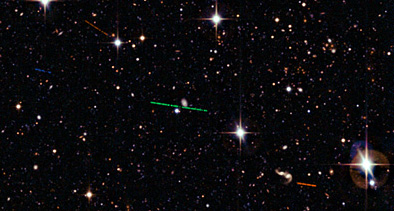What does it look like to stare into infinity? Like this:
Oh yes, you need to click that to see it in its glory. Because there’s a lesson here… When you look up at night, you might see a thousand stars. With binoculars, you might see tens of thousands. With a decent telescope, that number goes up to a seemingly amazing tens of millions.
This one image shows tens of thousands of trillions of stars. A million stars for every man, woman, and child on Earth, with more to spare. And it’s only one small part of the sky.
The stars are contained in thousands of galaxies, each so far away that their might and power is reduced to a smudge. Some are big enough to reveal some structure, a pretty splash of a spiral or a delicate swirl, but most are so distant they are mere points of light.
The image is dominated by Abell 315, a cluster of galaxies located two billion light years away. It’s a sprawling city of galaxies, hundreds of island universes bound by their mutual gravity. If each has 100 billion stars – a fair guess – then there are trillions of stars visible here in a glance… and that’s dwarfed, crushed, by the other galaxies scattered in this cosmic portrait.
The picture was taken by the European Southern Observatory’s 2.2-meter telescope at the La Silla Observatory in Chile. Incredibly, this picture is the combination of only about 2.5 hours’ worth of exposures! There are a handful of individual stars in the image; they are located in the foreground, in our own galaxy. They might be a few hundred or even a few thousand light years away. Everything else in the picture is millions or billions of light years away.
 … or, almost everything. See those colored streaks, the red, green, and blue lines? Those are asteroids, rocks a couple of kilometers across. They have different colors because this image is a composite of three separate exposures using a red, green, and blue filter. During each exposure, the asteroids moved a bit compared to the background stars and galaxies due to the combined motion of the rocks and the Earth, leaving streaks. The color of the streak corresponds to the filter used in the exposure.
… or, almost everything. See those colored streaks, the red, green, and blue lines? Those are asteroids, rocks a couple of kilometers across. They have different colors because this image is a composite of three separate exposures using a red, green, and blue filter. During each exposure, the asteroids moved a bit compared to the background stars and galaxies due to the combined motion of the rocks and the Earth, leaving streaks. The color of the streak corresponds to the filter used in the exposure.
Assuming these are main belt asteroids, they are perhaps 100 - 200 million kilometers away. Our space probes take months or years to get that far from Earth, yet these are the nearest objects by far in this picture! The most distant galaxy you can find in this image is something like 100,000,000,000,000 times farther away.
Every now and again, as does everyone, I find myself consumed with the drama in my life. Personal interactions, local troubles, global issues. These are all important, sometimes even crucial. But when I can, I try to remember to leverage myself out, to try to gain some perspective.
Gazing into the depths of space, plummeting into the environs of a hundred quadrillion suns… that’s where true perspective can be found.
Credit: ESO/J. Dietrich